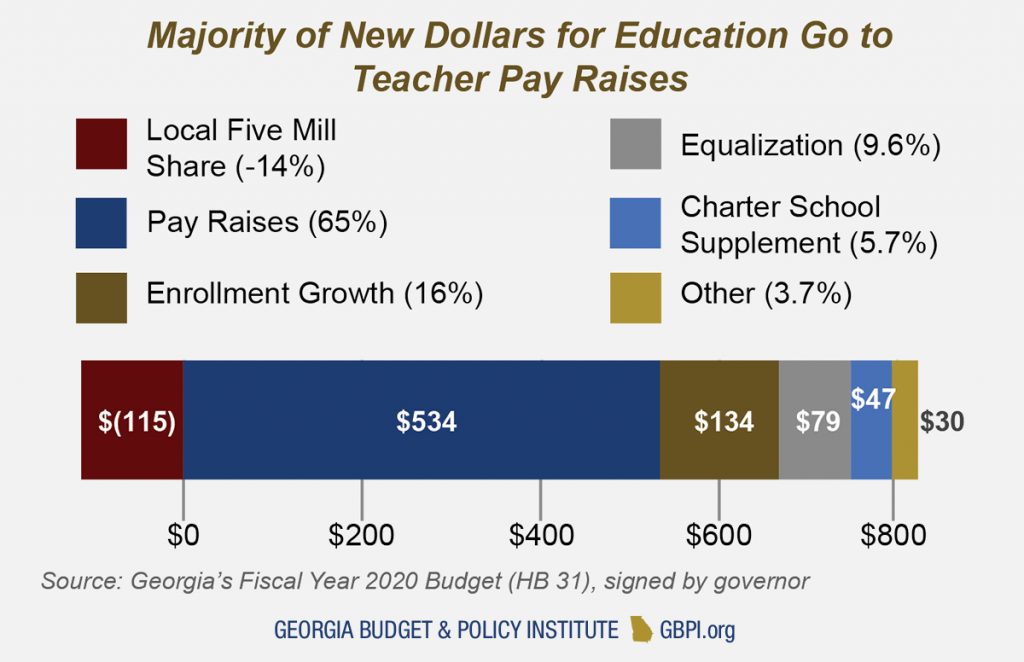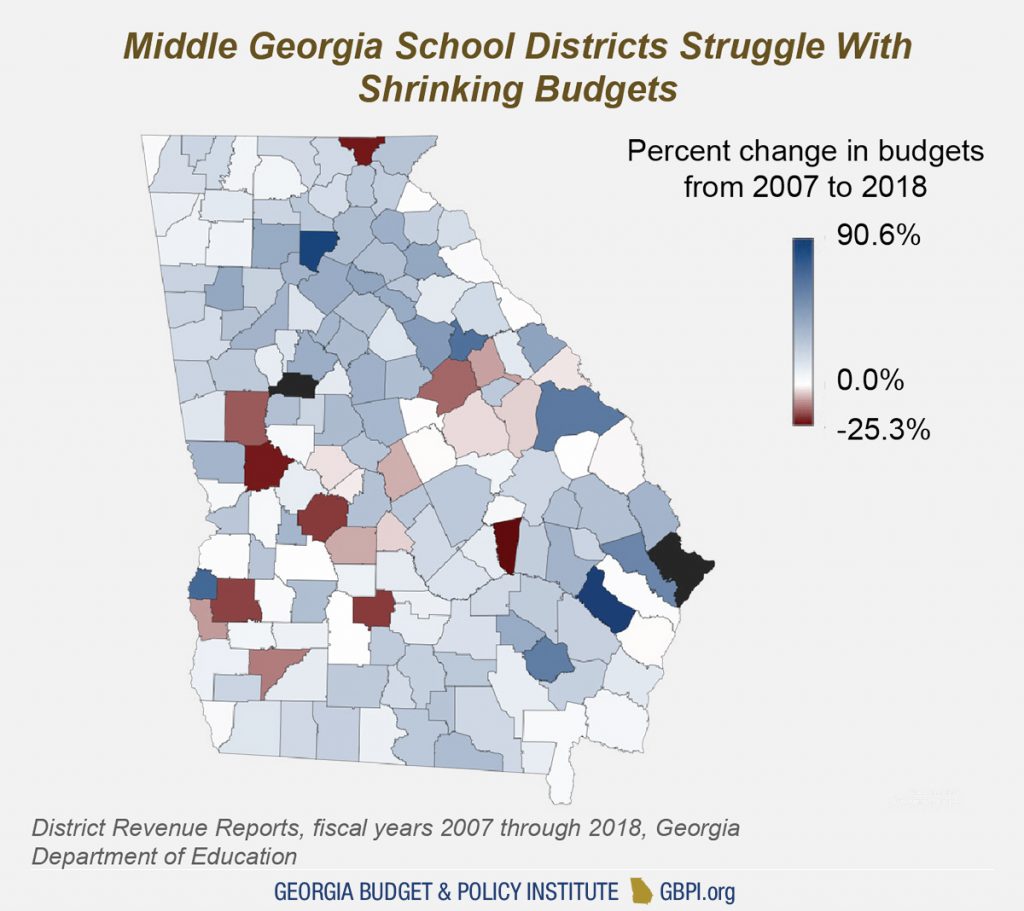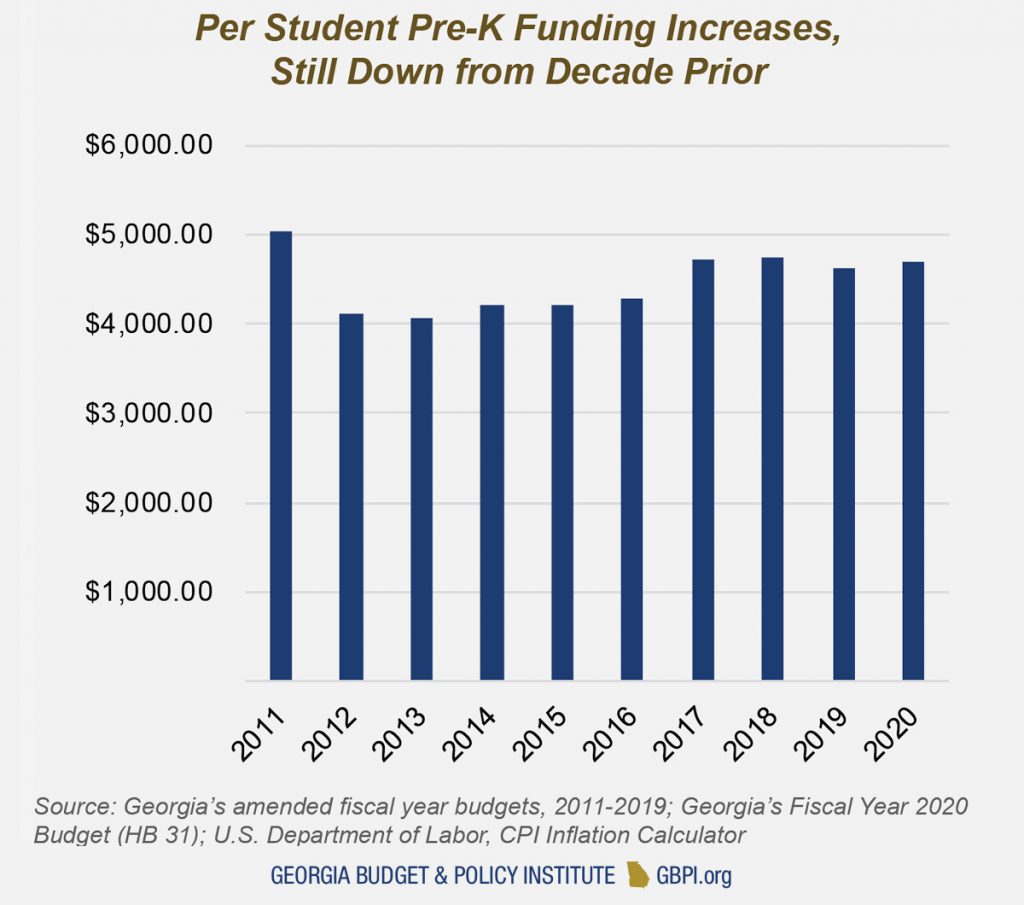You can download and share all the images and charts in the Education Primer by clicking here.
This section begins with K-12 education. Click here to jump to higher education.
Georgia lawmakers committed $707 million more to the state’s K-12 public education system in the 2020 budget than the prior year, for a total of $10.6 billion.
More than three-quarters of the funding growth covers salary increases for certified public school teachers and school employees. Pay raises and a second consecutive year of full funding of the state’s Quality Basic Education formula marks significant progress. However, many school districts still strain to operate due to a funding formula lawmakers made less equitable in recent years. For example, the state shrank the size of equalization grants that provide more support to low-wealth districts.
The Department of Early Care and Learning receives $61.8 million from the state’s General Fund. The Department of Education receives $10.6 billion. The higher education budget is $2.4 billion from the state for the University System of Georgia and $374 million for the Technical College System of Georgia.
Georgia allocates $139 million in state money for education programs administered by the Georgia Student Finance Commission. Dual Enrollment receives $101 million of that to pay for high school students who take college courses. Lawmakers cut the 2020 budget for Dual Enrollment by $3 million, even as participation continues to grow rapidly.
The Legislature also appropriated $1.2 billion in lottery funds for education: $379 million for Pre-Kindergarten and $857 million for college scholarships and loans, including HOPE Scholarships and Grants. Lottery reserve funds total more than $1.1 billion.
Teacher Pay Raises Drive K-12 Spending Increase
Georgia’s 2020 budget for K-12 education is $10.6 billion, an increase of $707 million over the prior year. Most of the new dollars are for pay raises for teachers from Pre-K through 12th grade. Legislators aimed for the allotment to raise the salaries of certified employees by $3,000 beginning July 1, 2019.
The $3,000 pay raises will require $529.8 million from the state General Fund for K-12 teachers and other certified employees. The money also allows for raises for school counselors, social workers, psychologists, media specialists, special education specialists and technology specialists. The General Assembly designated $3.7 million for merit-based pay adjustments and two percent salary increases for employees across the Department of Education, bringing the total to $533.5 million.
Lawmakers allotted $134 million for student enrollment growth and routine salary adjustments for training and experience, the second largest category of new education spending. Equalization grants are allotted $78.6 million to provide financial assistance to low-wealth school districts. Combined, these three appropriations account for 91 percent of the additional money for public education in the 2020 budget.
Middle Georgia Lags as Georgia Economy Grows
The average school district budget in Georgia grew by 24 percent since 2007. The state’s public school enrollment grew by more than 100,000 students in the past 13 years. Over this same time Georgia lawmakers imposed strict state spending reductions on school districts, known as austerity cuts. Lawmakers ended austerity cuts for public schools in the 2019 budget. The 2020 budget continues fully funding the Quality Basic Education formula, the state’s spending distribution system.
Even as enrollment grows and the state allots more money to local districts, many school systems are worse off than 10 years ago. School districts in middle Georgia are faring the worst. Twenty-three of Georgia’s school systems are funded at lower levels now than in 2007.
Pupil Transportation Costs Strain Local Schools
The state of Georgia continues a pattern of shortchanging pupil transportation in the 2020 budget. That shortfall triggers safety concerns and creates significant costs for local school districts. Student transportation is allotted $135 million through the Quality Basic Education funding formula for an 18.9 percent decrease compared to 2009. Over this same time, the costs associated with busing students increased year over year.
One culprit for rising transportation costs is the failure to account for the true needs of Georgia’s schools. Last year the funding formula only paid for 8,827 bus drivers even though there are closer to 14,700 of them statewide. State policymakers also shifted costs for the health insurance of non-teaching staff from the state to local school districts. Those and other expenses continue to reduce the state’s share of student transportation funding since 1991, when it covered 54 percent of total costs. Last year the state paid less than 14 percent of the total cost.
 Pre-Kindergarten Funding: More Money for Teachers, More Work to be Done
Pre-Kindergarten Funding: More Money for Teachers, More Work to be Done
Pre-Kindergarten funding is up 3 percent in 2020, with new lottery money available to cover teacher pay increases. The budget includes $15 million to raise lead teachers’ salaries by $3,000 and $1.5 million to provide a 2 percent raise for assistant teachers. At a salary of $15,873 per year for assistant Pre-Kindergarten teachers, this raise will amount to an additional $317 per year.
The investment in teacher salaries continues a recent trend that keeps Pre-Kindergarten funding on pace with inflation. Still, the state provides less per student for Pre-K than a decade ago. In 2011 Georgia allocated the equivalent of $5,038 per student when accounting for inflation, $338 more than in the 2020 budget.
Dual Enrollment Funding Cut
Georgia’s 2020 budget for Dual Enrollment is $101 million. The program is for high school students who take college-level courses that count for both high school and college credit. The state pays colleges fixed amounts. Colleges cannot charge high school students, though students can be responsible for course- specific fees and transportation costs.
Georgia’s Dual Enrollment program began in 2015, following the consolidation and simplification of duplicative programs. The program originally paid colleges for tuition, mandatory fees and books, as well as funding transportation grants. Participation grew rapidly, and the state more than doubled funding over the 2016 to 2019 fiscal years.
The 2020 budget cuts $4.2 million in state funds. The program’s administrator, the Georgia Student Finance Commission, eliminated payments for mandatory fees and books for the 2020 fiscal year. The state cut the $500,000 transportation grant in 2019.
 University System Funding Grows
University System Funding Grows
Georgia’s 2020 budget for the university system is $2.4 billion, about 10 percent of the state’s General Fund. Georgia allocates $2.2 billion to colleges and universities for student instruction. The state appropriates money to the Board of Regents, which manages Georgia’s public university system and allocates money among its 26 colleges and universities.
State funding increased 6 percent over the prior year. About one-third of the increase is for merit pay, recruitment and retention. A little more than half of it is for formula funding increases based on enrollment and facility square footage.
Per-student funding continues to increase after reaching its lowest point in 2012. But per-student, inflation-adjusted funding is still below pre-recession levels. Per-student funding dropped sharply after several years of budget cuts paired with enrollment increases.
 Technical College System Funding Relatively Flat
Technical College System Funding Relatively Flat
Georgia’s 2020 budget for the Technical College System of Georgia is $374 million, including funds for Adult Education services for Georgians without a high school diploma. The technical college system includes 22 colleges throughout Georgia. Technical college programs lead to associate degrees, certificates and diplomas.
Per-student funding and overall enrollment remain flat. Technical college enrollment often tracks the economy, as people who can not find work or lose jobs during economic downturns enroll in technical colleges to upgrade their skills. The largest changes in Georgia’s higher education 2020 budget from the prior year include an added $5.4 million for merit pay, recruitment and retention and a cut of $3 million for marketing.
The technical college system also administers Adult Education services for people without a high school diploma, the Quick Start program which delivers customized workforce training for Georgia businesses and the Office of Workforce Development.
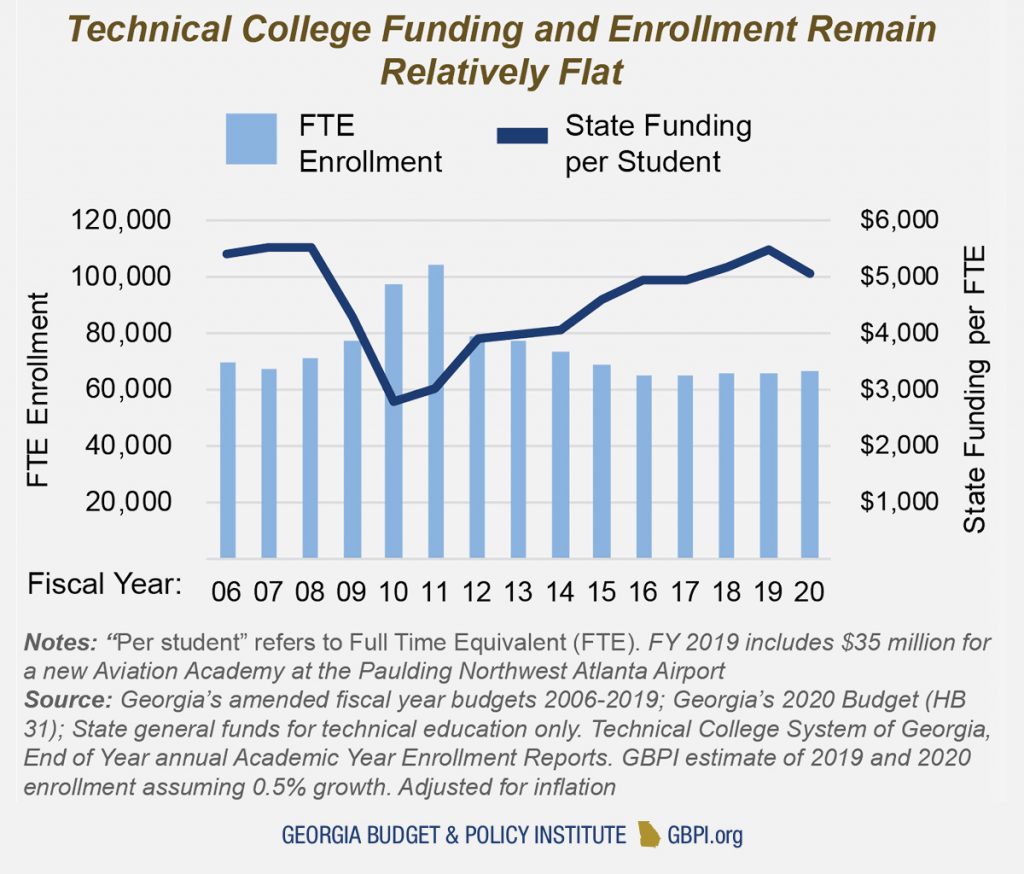 Lottery Funds: Support for Pre-K and College Students
Lottery Funds: Support for Pre-K and College Students
Georgia appropriated $1.2 billion from lottery sales to fund these education programs for 2020:
HOPE Scholarships (Public) – $703,115,948
For students pursuing bachelor’s or associate degrees in public colleges. This money pays for the partial-tuition HOPE Scholarship and the full-tuition Zell Miller Scholarship.
Georgia’s Pre-Kindergarten Program – $378,703,805
For 4-year-olds to access high-quality early learning. Georgia’s 2020 Pre-K funding includes a $16.5 million increase to cover raises for Pre-K teachers and staff.
HOPE Grants – $66,196,466
For students pursuing certificates or diplomas in technical colleges. This money pays for the partial-tuition HOPE Grant, full- tuition Zell Miller Grant and supplemental HOPE Career Grant, which covers full tuition for students in specific programs when combined with other HOPE grants.
HOPE Scholarships (Private) – $62,017,197
For students pursuing bachelor’s or associate degrees in private colleges.
Student Access Loans – $26,000,000
Provides low-interest loans to college students.
HOPE GED® – $1,930,296
One-time awards for students who complete a GED® and enroll in postsecondary education.
Lottery Reserves Top $1 Billion
The state appropriates more lottery money than it spends on Pre-K and HOPE programs. The unspent dollars, or surplus, transfers to reserves managed by the Office of the State Treasurer. In the 2018 fiscal year, more than $78 million in lottery surplus transferred to the reserves.
The Lottery Shortfall Reserve acts as a rainy day fund. If lottery ticket sales underperform leaving a shortfall for education programs, the state can draw on the reserve. Since 2011, the law requires the shortfall reserve to hold 50 percent of the previous year’s net lottery proceeds. After reaching this target, any money left is considered unrestricted reserves.
Lottery reserves continue to grow. In 2018, the shortfall reserve held $619 million and the unrestricted reserves held $550 million, for more than $1.1 billion combined.
 Lottery Funds Nearly All of State’s Financial Aid
Lottery Funds Nearly All of State’s Financial Aid
Georgia pays for financial aid through the state General Fund and the lottery. The lottery pays for 96 percent of state aid. The state’s 2020 budget allots $857 million in lottery-funded aid and $37 million in aid from the state’s general fund.
Financial aid eligibility falls into two categories. Need-based aid considers a family’s financial situation. Non-need-based aid rewards high test scores or grades, or targets students like members of the Georgia National Guard or those pursuing specific fields like engineering.
Georgia’s 2020 budget assigns $863 million for non-need-based aid and $31 million for aid that considers financial need. Aid that gives weight to need includes $26 million in lottery-funded loans and $5 million for the state-funded REACH program. REACH Scholarships are jointly funded by the state and school districts and serve about 1,800 students.
Lawmakers passed legislation in 2018 to create Georgia’s first broad need-based aid program, but the state did not fund it in either the 2019 or 2020 state budgets.
 State Funds Smaller Share of College Costs
State Funds Smaller Share of College Costs
Public colleges are funded through state appropriations, federal grants, tuition and fees. Generally, federal grants support specific research, state funding and tuition support instruction and student fees pay for services like housing, dining and athletics.
State money subsidizes the cost of higher education in public colleges and universities, lowering the price for students. Over the last decade, Georgia reduced its share of college costs and shifted the burden to students and their families.
Colleges continue to raise tuition and fees to meet budget pressures and higher expectations for quality. The University System of Georgia is the state agency with the most revenue outside of state or federal sources. Georgia’s 2020 budget counts on $2.3 billion in tuition and fees and a $2.4 billion contribution from the state. Though the university system’s funding formula assumes a 75/25 split between state funding and tuition, the current split is closer to 50/50.
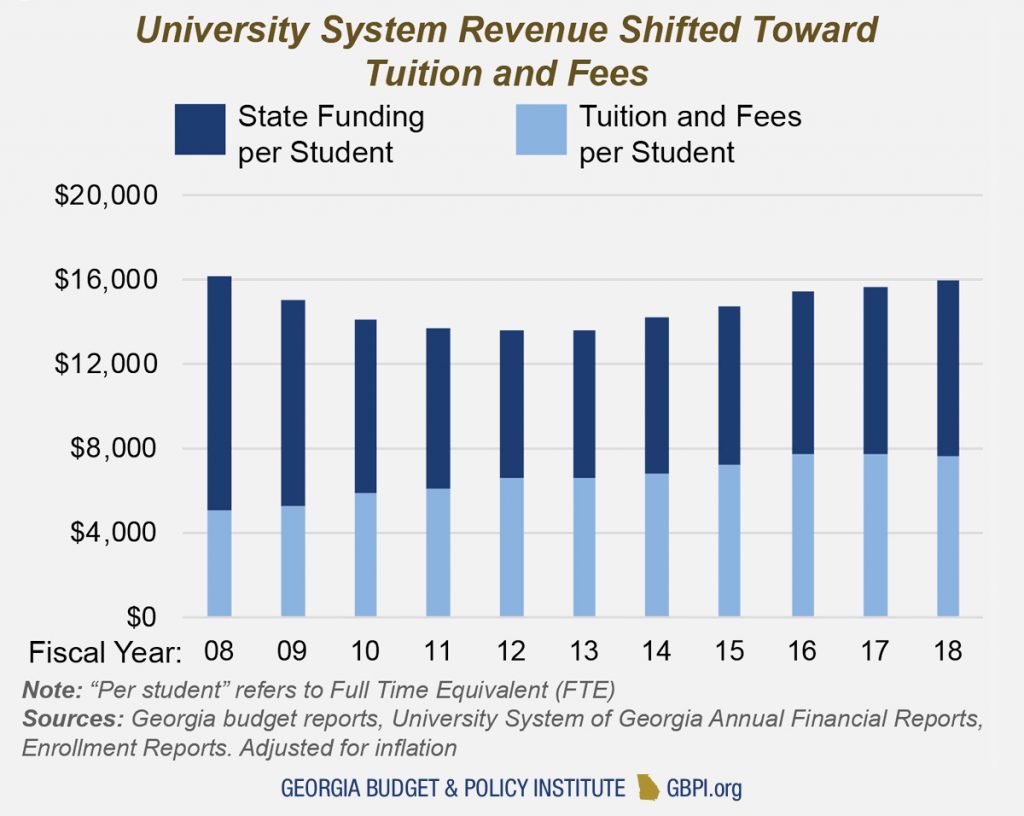 GBPI Policy Analyst Jennifer Lee contributed to the higher education section of the 2020 Georgia Budget Primer. You can view more of her work here.
GBPI Policy Analyst Jennifer Lee contributed to the higher education section of the 2020 Georgia Budget Primer. You can view more of her work here.
Continue reading the 2020 Georgia Budget Primer
|
|
|
|
|
|
